Michelle Cooper's Blog, page 10
December 25, 2017
‘End of Term’ by Antonia Forest
I’m very happy to be back at Kingscote with the Marlow twins, a year after their eventful Autumn Term, because I have plenty of questions I need answered. Did Nicola get promoted to Form IIIA, leaving Lawrie and Tim behind? Will Nicola get a chance to triumph on the netball courts this year? Will she ever find a worthy Best Friend? How will Ann cope with being Eldest Remaining Marlow Sister? And who will be Head Girl now Karen and Rowan have departed? (Surely not Lois Sanger. But the teachers seem clueless as to Lois’s true character, so it’s possible.)
 It seems that Christmas is a good time to begin reading End of Term, because the plot seems to feature a Nativity Play. That’s pretty much all I know about this book. The cover is not very informative or even very accurate – if that’s the twins with their new short hairdos in front, why are they wearing scarlet uniforms? Unless Nicola used her Boke of Falconerie windfall to buy uniforms, which seems pretty unlikely…
It seems that Christmas is a good time to begin reading End of Term, because the plot seems to feature a Nativity Play. That’s pretty much all I know about this book. The cover is not very informative or even very accurate – if that’s the twins with their new short hairdos in front, why are they wearing scarlet uniforms? Unless Nicola used her Boke of Falconerie windfall to buy uniforms, which seems pretty unlikely…
Chapter 1: Sprog Takes a Quarry
So, we begin at Colebridge Junction where Ann, Ginty, Nicola and The Sprog are waiting resignedly for their train to school and Lawrie is acting like a fractious five-year-old. Kingscote is a mere forty minutes by road from Trennels, but do the Marlow parents do the sensible thing and drive the girls and their luggage to school? No, they make them take a three-hour train trip, so the sisters can bond with their fellow pupils on the journey and Nicola can do something dramatic and dangerous to start the book off with a bang. (By the way, I always wondered about the Hogwarts school train. Did Scottish students need to travel all the way to London to catch the train all the way back to Scotland? If they could Floo or Side-Along Apparate with their parents to London to catch the train, why couldn’t they just travel directly to Hogsmeade, then get on the boats or carriages to Hogwarts?)
Anyway, after helping Ginty avoid Unity Logan and watching Lawrie boasting about her new theatrical mentor to Tim and company, Nicola sensibly decides to take The Sprog to the relative peace and quiet of the guard’s van. Everything is going swimmingly until they stop at the penultimate train station and The Sprog flies out the open door after some birds and Nicola tears off after him. Well, at least this time the train was actually stopped of its own accord at a station when she leapt out. And she does catch up with The Sprog, and even better, he’s caught his first sparrow (probably accidentally, but they’re both very proud of him). They trek back to the station, to find the next train isn’t due for three hours and worse, a new girl called Esther Frewen, who snubbed Nicola’s welcoming gestures on the train, is there too, after trying to run away back home.
Nicola really is a very kind and sympathetic child, even if she doesn’t always understand others’ insecurities and anxieties, being a very secure and fearless person herself. She realises they can walk to school across the fields and she tactfully talks about Sprog and school and the famous Marlow family until Esther gets her tears under control. Poor Esther is the only child of divorced parents, which must have been pretty unusual in 1950s England, although Nicola thinks “there were quite a few people at Kingscote to whom this beastly thing had happened”. Even worse, Esther’s had to leave her young puppy, Daks, at home because new girls aren’t allowed to bring pets (yet another of Kingscote’s arbitrary and illogical rules, I suppose, although I do wonder why Esther got a new puppy just when she was about to leave for boarding school).
Back at school, poor Ann is in a flap about Nicola going missing (“You wouldn’t have done this to Rowan”) and has already unpacked Nicola’s things into her drawer completely the wrong way:
“What with depressed new girls and pained sisters and misarranged drawers, Nicola saw no hope for the term at all.”
Such trials and tribulations! So Nicola stomps off to see to Sprog.
Chapter 2: Friends and Enemies
Ugh, Miss Redmond! She corners Lawrie and Nicola on their very first day back and graciously condescends to permit them to rejoin the Guides, saying “everyone was most anxious to be able to feel they could forget the whole unfortunate affair and begin again with an entirely clean sheet”. Oh, and Lois Sanger “was very keen to have them back with the Scarlet Pimpernels”! Lawrie, as usual, goes “scarlet and dumb” and expects Nicola to respond: Nicola quite rightly tells Miss Redmond to go jump in the lake. Miss Redmond storms off in an outraged huff and Tim appears, enjoying the strife. It seems Tim and Lawrie are now Best Friends Forever and both of them quite like Lois after she helped them with their play, but Nicola does not forgive and forget so easily.
Fortunately, Nicola seems to have found a new friend in Miranda West:
“Their hands banged together, and clasped and swung energetically as they went along the path to the outhouse. It was odd how people changed – or else you did – Nicola wasn’t sure which. A year ago, Miranda West had been one of III A’s form prefects, a bossy, conceited person, who made no bones about despising the worms of Third Remove. Then first [Nicola], and later Lawrie and Tim, had moved into III A themselves … and suddenly, last summer term, she had become someone to grin at across the classroom – someone who saw the same joke at the same time as you did.”
Miranda is described as having a “vivid, clever little Jewish face” and having “extremely rich” parents. She does seem to share Tim’s disregard for school rules, but has slightly more School Spirit and is worried that now Rowan has left, they might end up with Lois Sanger as Games Captain (Miranda accurately describes Lois as “slippery soap and slithery slime”). And worse luck, Lois has been made Games Captain, as well as being a prefect! Lois is busy crowing to her friends about how Rowan hasn’t even been made a prefect, when Nicola storms up to inform her that Rowan has left school. Take that, Lois! Nicola storms off, leaving Lois’s friends moaning about kids these days, no manners, etc. There’s a lot of storming off in this chapter.
Someone useless called Val Longstreet is Head Girl (to replace useless Karen) and someone called Janice Scott is a prefect, although Miranda wishes Janice had been made both Head Girl and Games Captain. Miranda has a bit of a crush on Janice, but denies it (“I mean, I like looking at her, quite, but not if you mean giving her roses in silver paper, and sleeping with her kirbigrips under my pillow”). Apparently the kirbigrips thing really happened a few years back, with some Lower Fifths obsessing over a couple of older girls, until Miss Keith called a special school assembly to shame the younger girls in the most public and humiliating way possible. (Because she couldn’t possibly have had a quiet sensible word with them right at the start about respecting other people’s privacy, before they got obsessive, and given them a copy of The Friendly Young Ladies.)
Then Nicola and Miranda meet up with Tim and Lawrie. Tim distributes chocolates and Lawrie complains about “the beastliest First Day I’ve ever met”. It turns out the cast list for the Christmas Play has been posted on the noticeboard, and casting depends on good character, not acting or singing talent. Accordingly, Lawrie and Tim are only Crowd. Nicola, who has a much better character, is a Candle Angel. A nice but useless girl called Jess Geddes is Shepherd Boy, the role that Lawrie covets. Ann is Mary, which makes sense, Val is Joseph because she’s Head Girl, and slimy Lois is Reader Angel (although at least Lois has proven reading-aloud skills). Miranda isn’t in it at all, presumably because she’s Jewish (she refers to it as “your play”). I can’t see why she can’t join in, though. She wants to be in it and it’s only a school play. If it’s like most of the Nativity Plays I’ve seen, with singing sheep and so on, it won’t even be particularly Biblical (not that the Gospels tell a consistent story about the birth of Jesus anyway) and it’s being held in a school theatre, not a church. Anyway, I’m sure there’ll be major drama involving the casting before too long.
Next, Chapter Three: Rehearsals and Team Practices
You might also be interested in reading:
‘Autumn Term’ by Antonia Forest
‘The Marlows and the Traitor’ by Antonia Forest
‘Falconer’s Lure’ by Antonia Forest
December 24, 2017
My Favourite Books of 2017
It’s not actually the end of the year, but if I don’t post this now, it may not get done at all. I only read 37 new books this year (new to me, that is) – even fewer than last year. I did immerse myself in blogs and newspapers, trying to make sense of the political turmoil here and abroad, but I also re-read a lot of old favourite novels. This year was not an especially relaxing year for me, so I often felt a need to escape into familiar comforting reads and I don’t count those books in my annual book count.
So, what type of new (to me) books did I read this year?

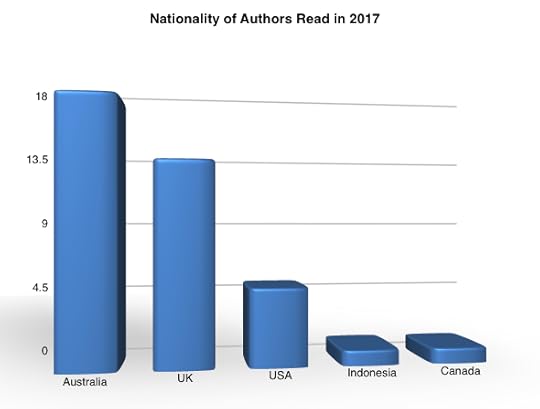
Lots of Australian writers this year.
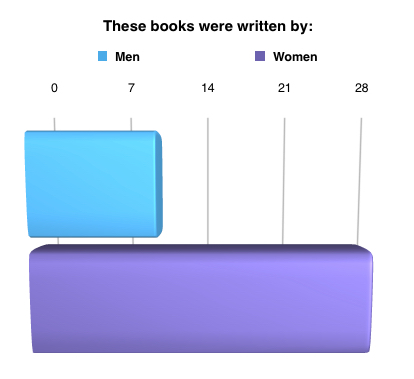
Women writers dominate, yet again. And so they should.
Now for my favourites.
I really enjoyed Tirra Lirra By The River by Jessica Anderson and How Bright Are All Things Here by Susan Green – both, as it happens, novels narrated by elderly Australian women who had to escape to London to fulfil their artistic dreams.
But most of my favourite reads this year were non-fiction. These included:
Mad World: Evelyn Waugh and the Secrets of Brideshead by Paula Byrne
Indonesia, Etc: Exploring the Improbable Nation by Elizabeth Pisani
Other Minds: The Octopus and the Evolution of Intelligent Life by Peter Godfrey-Smith
I didn’t have time this month to blog about Beyond Veiled Cliches: The Real Lives of Arab Women, but this was a thoughtful, nuanced exploration of the challenges faced by Arab women in the Middle East and in Western countries, by Australian-Palestinian journalist Amal Awad.
I also found myself engrossed in a couple of Australian memoirs, Aunts up the Cross by Robin Dalton and Flesh Wounds by Richard Glover.
My resolution for next year is to blog more about the books I enjoy, or at least to mention these books on Twitter. In the meantime, I have this book on the top of my reading pile for the holidays:

I foresee an Antonia Forest read-along in the near future.
Thank you to everyone who read and contributed to Memoranda in 2017. I hope you’ve all had a good reading year and that 2018 brings you lots of wonderful, interesting books. Happy holidays!
November 20, 2017
Adventures in Self-Publishing: Turning Your Manuscript Into A Book
The arrival of ebooks has made it much easier for self-publishers to get their work into the hands of readers, but I always knew I wanted to see Dr Huxley’s Bequest as an actual paper book that I could pick up (and be able to read, because I don’t own any kind of ereader). But how does a self-publisher on a limited budget, expecting to sell only a few books, go about turning their work into printed books?
At first I assumed I’d have to do it the way that traditional publishers print books, just on a much smaller scale – that is, pay a printer to produce a limited number of copies using a traditional press. But this means working out how many books you want and paying for all of them up front. I did consider using a crowdsourcing platform (such as Kickstarter) to fund a small print run, but the more I researched, the less attractive this option appeared. These companies take a significant percentage of the money raised and have all sorts of unappealing conditions attached. Anyway, I doubted I’d attract enough contributors to make it worthwhile. And even if I myself paid for a print run, where would I store all the books? How would I sell and distribute them to readers?
Then I did some research and discovered the amazing world of digital Print on Demand (POD) publishing. This means that you print only the copies that have been ordered, when they’re ordered. You can order just one book for yourself or hundreds of books. The POD publisher will print them in a couple of days and send them to you – or, even better, send them to the bookstore or library service that ordered them, charge them the price you’ve chosen for your book, deduct the printing and distribution costs, and pay you the remainder.
This is how it works. You, the author/self-publisher, send the POD publisher two pdf files – one pdf of the inside of the book, laid out the same way any printed book is, and one pdf of the cover art, with front, back and spine art fitted into a template that the POD publisher supplies. They store these files in their computer and whenever a book is ordered (either by you or by booksellers), this happens:
Isn’t that cool? You can choose from a wide range of book sizes. You can print paperback or hardcover copies with a range of binding types and jackets and types of paper. I can confirm that the printed paperbacks look just like the trade paperbacks you can buy in a bookstore. The only issue I noticed with the particular POD publisher I used (Lightning Source/IngramSpark) was that some of the colours on the cover were lighter than I expected, which I’ve heard isn’t uncommon with digital printing-on-demand. And you can’t do really fancy things with cover design, such as cut-outs and embossed lettering. It’s also more expensive to print per book than if you printed a thousand copies at the same time using traditional off-set printing. However, for a self-publisher, print-on-demand is an affordable and practical way to produce print books. You don’t have to pay warehouse costs and you don’t waste any paper if your books don’t sell.
The other good thing about IngramSpark, for Australian self-publishers, is that they have printing facilities around the world, including in Australia, and they can deposit your book sale earnings directly into your Australian bank account. That’s one of the reasons I ended up going with IngramSpark rather than Amazon Createspace, the other big name in the self-publishing world. I also thought IngramSpark would work well for me because they’re connected to dozens of online bookstores and library suppliers around the world. If you choose to distribute through IngramSpark, you give them information about your book (cover image, book summary, author information and so on) and they send it to all their affiliated booksellers, who then sell the book through their websites and catalogues. If you choose Amazon Createspace, the book is only sold through Amazon sites – which do reach a lot of bookbuyers, but not everyone wants to buy their books from Amazon.
For ebooks, a similar process occurs. The file is uploaded to IngramSpark in a different format (epub rather than pdf) and it doesn’t have to get printed, but it’s still listed and sold through a range of international booksellers, including Kobo, Apple iBooks and Barnes & Noble. However, if you want your ebook to be available for Kindle readers, you need to format it as a mobi file, set up an account with Amazon, and sell it through them. I had no idea which ebook format was likely to be more popular with Dr Huxley’s Bequest readers, so I’ve made it available in both formats. I’ll be interested to see the sales numbers and how much I earn from each.
I have skimmed over a very important step, though. You can’t upload a Word document, no matter how pretty it looks, to a POD publisher. So how do you turn your edited manuscript into formats that will look good when they’re read in either print or ebook form? You either do it yourself, which requires a fair amount of technological and design skill, or you pay a professional to do it for you. Now, remember back when I started this series and I said it could end up being a What Not To Do? Yep, this is the bit where I made All The Mistakes. That’s coming up in the next post.
Previously in Adventures in Self-Publishing:
Why Self-Publish?
What’s This Book About, Anyway?
Editing
To Tweet Or Not To Tweet
Designing a Book Cover
November 16, 2017
A Guide to Australianisms in ‘Dr Huxley’s Bequest’
Dr Huxley’s Bequest is about two Australian teenagers, Rosy and Jaz, who live in Sydney and speak Australian English. I think most of their Australianisms make sense in context. However, when I uploaded the Kindle version, Amazon.com was VERY CONCERNED about terms such as ‘esky’ and ‘ute’. So, for those readers who aren’t Australian, here’s some additional information about the Australian terms and cultural references in Dr Huxley’s Bequest.
Firstly, an esky is a portable cooler or ice box, usually made of sturdy polypropylene. Inside is ice or those freezable ‘ice’ bricks, which keep your freshly-caught fish, barbecue meat or canned drinks nice and cold. Eskys are usually big enough to use as a picnic seat or, if your boat sinks, a flotation device. Apparently in New Zealand, they call them CHILLY BINS! New Zealanders have the best slang.
A biscuit is a cookie. I’ve talked about this before.
Australians, including Rosy, are very fond of putting slices of pickled beetroot in their salad sandwiches and hamburgers. We also put canned pineapple on pizza.
A ute, or utility vehicle, is a pickup truck with an enclosed cabin for a couple of passengers and an open flat-bed platform at the back. According to Wikipedia, the Australian ute was “the result of a 1932 letter from the unnamed wife of a farmer in Victoria, Australia asking for ‘a vehicle to go to church in on a Sunday and which can carry our pigs to market on Mondays’.” Traditionally, Australian utes have a couple of hay bales and some cattle dogs bouncing around in the back. In Dr Huxley’s Bequest, Jaz’s dad keeps his gardening equipment in his ute.
A eucalypt is a eucalyptus tree or a ‘gum tree’, native to Australia and to other parts of the world. You already know that, don’t you? I don’t know why Amazon.com had a problem with the word. Anyway, there are hundreds of different types of eucalypts, all beautiful and usually home to a lot of interesting and extremely noisy wildlife. Some of these animals are extremely possessive of ‘their’ gum tree:
While on the topic of big bullies, Ned Kelly was a murderous, racist thug who is inexplicably worshipped by many contemporary Australians. He was born in 1854, the son of an Irish convict, and started his criminal career at the age of fourteen when he bashed and robbed a Chinese-Australian farmer. He spent the next ten years stealing cattle and horses, robbing farmers and shops and banks, and killing people. He’s best known for his decision to make body armour and helmets out of old ploughs. This, he asserted, would be bullet-proof. It was, but it was also extremely heavy, which made movement difficult, and it didn’t cover his legs. So when Ned Kelly was finally cornered, the police shot him in the legs and he fell over and was captured, and later hanged. Captain Moonlite is another bushranger mentioned in Dr Huxley’s Bequest.
Finally, Rosy makes a brief reference to ‘Slip, Slop, Slap’. This was a very successful advertising campaign in the 1980s, devised by the Cancer Council of Victoria to encourage Australians to protect themselves from the sun. That’s because Australia is a very hot place and contains a lot of fair-skinned people vulnerable to deadly skin cancers. In the ad, a singing, dancing seagull tells people to Slip on a shirt, Slop on some sunscreen lotion and Slap on a hat:
If I’ve missed anything and you find something confusingly Australian in the book, feel free to ask about it!
November 13, 2017
How To Buy ‘Dr Huxley’s Bequest’
My new book, Dr Huxley’s Bequest, is out this Wednesday, 15 November. I just received my author copies of the paperback. It has a very nice cover:
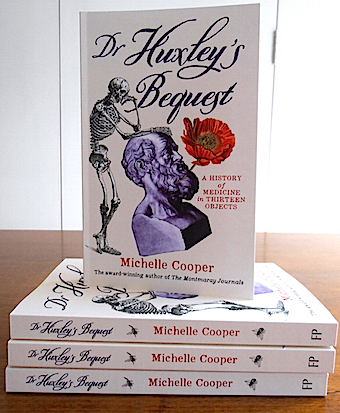
And there are illustrations inside:
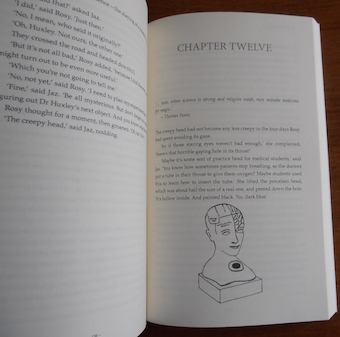
It’s also available in various ebook formats.
Which type of book should I buy?
The paperback has illustrations, author notes, a bibliography, a comprehensive index and a pretty cover.
However, the font is fairly small, so if you prefer large print, I recommend choosing an ebook edition, which you can resize to suit your reading needs. The ebooks are available in two formats. There’s a Kindle (mobi) version for Kindle readers and other devices that have the Kindle app installed. There’s also an epub version, for iPads, iPhones, Nook readers, Kobo readers, and pretty much every other sort of ebook reading device. The ebooks don’t have the illustrations or the index, but do have a search function if you want to find keywords.
Where can I buy the book?
Here are some of the online stores where you can buy Dr Huxley’s Bequest. I’ve listed stockists according to geographical region, because delivery costs are cheaper and you won’t have to pay currency conversion fees if you buy locally.
Australia and NZ
Amazon.com.au (Kindle ebook)
Angus & Robertson Bookworld (paperback)
Apple iBooks (iBook ebook)
Booktopia (paperback)
Kobo (Kobo ebook)
North America
Amazon.com (Kindle ebook)
Apple iBooks (iBook ebook)
Barnes & Noble (paperback, Nook ebook)
Chapters/Indigo Canada (Kobo ebook)
Kobo (Kobo ebook)
UK and Europe
Adlibris (paperback)
Amazon.co.uk (paperback, Kindle ebook)
Apple iBooks (iBook ebook)
Book Depository (paperback)
Kobo (Kobo ebook)
You can pre-order now and they will send the book to you on Wednesday.
Will it be in my local bookshop?
Maybe, if you ask them to order it for you! But possibly not even then. Bookshops don’t usually stock self-published titles.
Can I borrow it from my library?
Maybe, if you live in Australia. If it’s not in your library’s catalogue, you can ask your librarian to order it. The book is listed with ALS Library Services and it has a National Library of Australia catalogue number.
If you’d like to know anything else about how to purchase Dr Huxley’s Bequest, ask away! (I am planning on continuing my Adventures in Self-Publishing series of blog posts so you can find out more about How Not To Make The Same Mistakes I Made.)
Oh, and Dr Huxley’s Bequest is also listed on Goodreads, if you feel like leaving a rating or a review.
November 6, 2017
Read an Excerpt of ‘Dr Huxley’s Bequest’
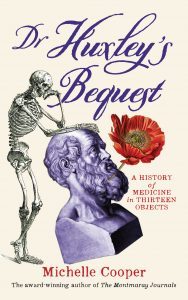 I’ve updated my website with an excerpt of my new book, Dr Huxley’s Bequest.
I’ve updated my website with an excerpt of my new book, Dr Huxley’s Bequest.
There’s also a virtual tour of the real places explored in Dr Huxley’s Bequest, but it will probably make more sense after you’ve read the book. Teaching resources will be available for download in January.
Dr Huxley’s Bequest will be available in paperback and in ebook versions (epub and Kindle) later this month. I’ll put up links when it goes on sale.
October 22, 2017
Adventures in Self-Publishing: Designing a Book Cover
The first piece of advice most self-publishers hear is that there are two areas in which they must get professional help: editing and cover design. I’ve previously discussed how useful a professional editor was in preparing my manuscript of Dr Huxley’s Bequest for publication. Now I’m going to talk about cover design.
A book’s cover is a vital part of selling the book to readers, so it’s important that it conveys the book’s ideas, genre and audience in an efficient but attractive manner. There was no way I was going to attempt to make my own book cover, because I have no design expertise whatsoever. I am, however, able to recognise bad book covers and I could see that a lot of self-published book covers were absolutely terrible. Most of the companies that offer services to self-publishers include reasonably-priced cover design, but cover samples on their websites are universally awful – cheap-looking, genre-inappropriate fonts, ineptly Photoshopped across generic images. I really think this is one area where you get what you pay for.
I wanted my book to look professional, so I searched the professional directories of Australian book designers and eventually found Nada Backovic, who had lots of experience working with Australian publishers, was willing to work with a self-publisher and could fit into my publication schedule and budget. My first task was to prepare a design brief for her. This contained technical specifications (for example, the width and length of the book and the text that needed to go on the front and back cover and the spine) but was mostly about the information that the cover needed to convey. I sent Nada a one-page synopsis of the book, a sample chapter and a description of who the book’s buyers and readers would be. My book, Dr Huxley’s Bequest, involves the characters embarking on a quest to identify thirteen objects, so I gave Nada a list of these objects and included photos of those that might look good on the cover. I included some of the illustrations from the book, photos of the real-life setting, and some book covers that had appealed to me, for books about similar themes or for similar readers.
This was the stage when I began to understand the concerns of traditional publishers about marketing this particular book. It wasn’t that I’d doubted them when they said it would be too difficult to market (presumably, they knew more about book marketing than I did). It was just that I didn’t fully comprehend all the practical implications back then. I have to admit, Dr Huxley’s Bequest is a weird book. It doesn’t fit neatly into one marketing category, the way a Regency romance or an action thriller or a paranormal horror novel would. This meant that I ended up with a design brief full of contradictory statements. It’s non-fiction, but it’s a mystery story so it needs to look entertaining and fiction-y! But it’s full of history and science and ethical questions, so the cover needs to convey thoughtfulness! But also humour! And it should appeal to teenage girls, but I don’t want it to look all pink and glittery and stereotypically feminine! Oh, and it also has to appeal to parents and teachers! And I hate yellow covers! Don’t make it yellow!
It is a measure of Nada’s professionalism that she did not run screaming into the night when she received this brief, but instead quickly produced eight attractive, appropriate, non-yellow cover roughs. Four of the covers featured lots of images, effectively conveying the idea of thirteen historical objects. But these covers looked a bit cluttered and the book’s theme was already being conveyed by the subtitle, A History of Medicine in Thirteen Objects. So I concentrated on the other four covers, which were based around a single illustration of a cross-sectioned skull, with a pink tongue sticking out. It was a really good, strong image that related to the book’s themes, but I worried it might look a bit too serious and gory and put off some potential teenage girl readers. Then I noticed that some of the other covers included a composite image of two of the thirteen objects, a stone bust of Hippocrates and a skeleton illustration from Vesalius. Nada had cleverly combined them so that the Enlightenment skeleton was leaning upon the Classical bust, looking down on it with fondness and some amusement. That was it. That was the image I wanted for the cover.
But there was also the font to decide on. It’s amazing how the lettering for a title can convey so much information about the book’s readership. In the end, I thought an elaborate Victorian-style font would fit the title best, once some of the flourishes had been removed to make the lettering easier to read. The subtitle and author information would be in an old-fashioned, slightly wonky typewriter-style font that helped to convey the non-fiction nature of the book. I considered fonts that looked more ‘junior readership’, but ultimately, I didn’t think they worked. Readers drawn in by a wacky, zany title font would expect a light, fun, super-easy read and that’s not really what the book is like. It does have jokes and pictures, but it’s also fairly long and aimed at thoughtful readers.
Then came a series of small tweaks to the placement and colour of the images and text. For example, at one stage the bust of Hippocrates was staring off the page, which I thought drew the reader’s gaze away from the title, so Nada tilted Hippocrates slightly on his base, which also made the image look a bit more dynamic and amusing. I’d initially wanted the colours to be plain red, white and blue, but Nada correctly pointed out that the cover would look warmer with a cream background and more red. (We even experimented with pink text and then a pink background. It didn’t work.)
Then there was the back cover. There wasn’t much space once the text was in place, but it needed some pictures. I wondered if one of the medicinal plants mentioned in the book might suit and fortunately found a lovely red opium poppy from a historical botanical collection, as well as some vintage bee illustrations (honey also makes an important appearance in the book). Nada had the good idea of adding the poppy to the front cover, weaving it through the beard of poor long-suffering Hippocrates, then she stuck some bees on the book spine, and then we were done!
One thing I forgot to mention, which is important for self-publishers on a tight budget – if you want to use fonts or photos or illustrations, you may have to pay licence fees, unless you’re very careful and clever about your choices. In the case of Dr Huxley’s Bequest, I was able to locate appropriate historical images that were in the public domain or covered by Creative Commons licences (that is, free of charge but I needed to acknowledge the licence holder in the book, which I did). The only image I paid for were the vintage bees, which cost $36 from iStock. It’s important to note that some photos, even historical ones, can cost thousands of dollars to use. I have no idea how much it cost my American publishers to usethe beautiful Frances McLaughlin-Gill photograph on the cover of The FitzOsbornes in Exile, but I’m sure it was a lot. (It was totally worth it, though. That gorgeous cover was responsible for a lot of readers picking up the book and then reading the whole series.)
Oh, so I guess I’d better show you the cover of Dr Huxley’s Bequest. Here’s the front:
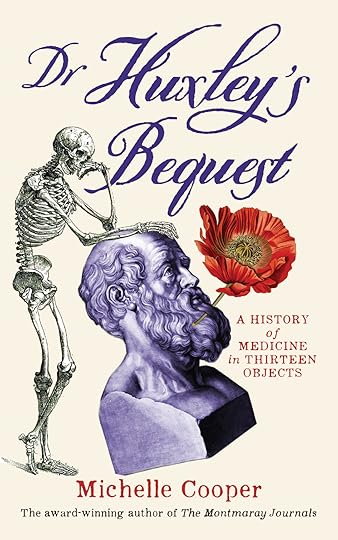
And here’s the back cover:
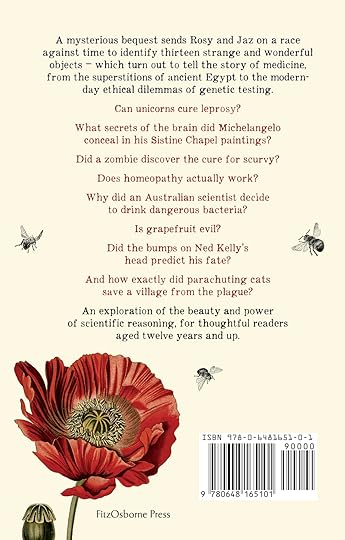
Previously in Adventures in Self-Publishing
Why Self-Publish?
What’s This Book About, Anyway?
Editing
To Tweet Or Not To Tweet
September 22, 2017
‘You Can Draw in 30 Days’ by Mark Kistler
I did the illustrations for my new book myself, mostly because I was on a limited budget and couldn’t afford to pay illustrator fees. These illustrations definitely don’t look like the work of a professional, which is okay because they’re supposed to have been done by the thirteen-year-old narrator. But as I was working on my less-than-perfect illustrations, I remembered how much I used to enjoy drawing when I was a teenager. I did art as an elective subject at high school and proved to be spectacularly untalented at most artistic endeavours – painting, sculpture, pottery, screen printing – although I was okay at drawing. Maybe the idea of perspectives and vanishing points and so on appealed to my nerdy maths brain. Anyway, I had so much fun doing my recent book drawings that I decided I wanted to do a bit more guided practice and eventually found this book by Mark Kistler, who apparently is famous in the US and used to be on TV.
This book was a great introduction to basic drawing techniques. It’s designed for absolute beginners with no confidence in their own abilities, so it was ideal for me, given I’d barely picked up a pencil in thirty years. There are thirty lessons, which you could do in thirty days, although I didn’t have time to spare every day for a month and so I stretched the lessons out over three months. The lessons teach the fundamental ‘laws’ (foreshortening, placement, overlapping, shadow and so on) that make pencil marks on a page look like three-dimensional objects, but it’s done in a simple, easy-to-follow manner that provides quick success and builds confidence.
I zoomed through the early lessons on spheres, cubes, spheres inside hollow cubes, pyramids and textures, coming unstuck only when I hit cylinders. Something about the combination of curved and straight lines did my head in. But the book gives lots of practice in each skill, over multiple lessons, and so I persisted, valiantly producing wonky tins of tomatoes:
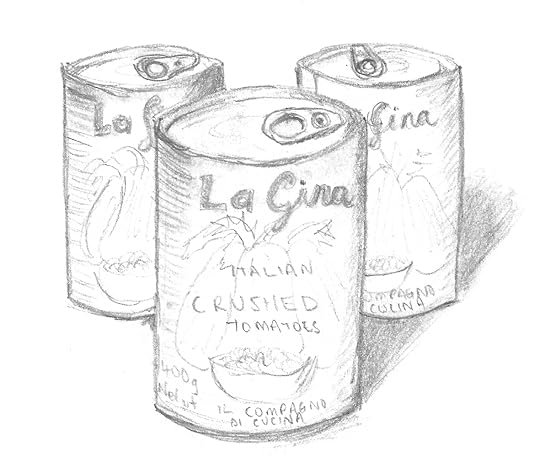
And wonky tubes:

And wonky mugs with wonky handles:
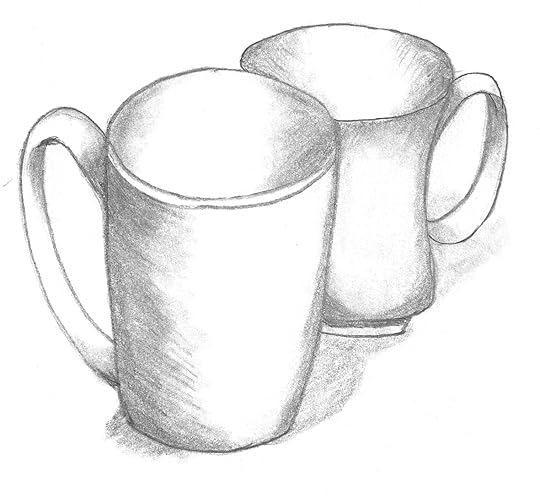
Then came interiors and exteriors of buildings in one-point and two-point perspective. Phew, mostly straight lines again, what a relief:
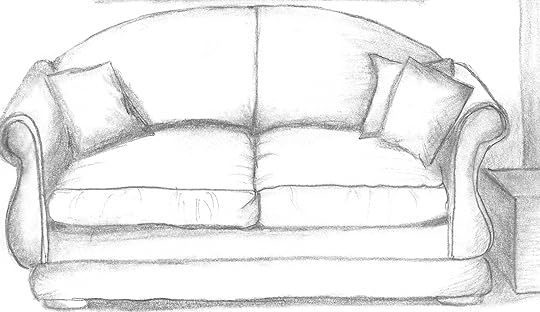
Mark Kistler is a cartoon illustrator, so he also provides instruction in some basic cartooning skills, such as 3D lettering and cartoon whooshes and cartoon planets consisting of volcano craters and levitating boulders. Then in Lesson 28, we suddenly had to draw faces. This seemed an enormous leap to me, but once I started, I realised I was using the same principles and skills I’d been practising all along. Admittedly, my first face was only vaguely face-like, but I kept going for a few days and my face drawings got better and better:



The final lesson, though, was to draw your own hand. You know what fingers are? CYLINDERS! It’s also pretty difficult using your right hand to hold the pencil while you draw your own left hand. I am definitely in need of more hand-drawing practice, ideally using someone else’s hand as a model.
The good thing about drawing is that you don’t need anything except a pencil and some paper. Kistler provides suggestions for a few other useful drawing tools, but they weren’t expensive. I ended up spending less than twenty dollars in total on a nice thick sketch book, a smudging tool, some pencils and a nifty retractable eraser. Kistler is also a fan of tracing as an instructional method and he recommends a complicated arrangement involving a transparent clipboard, erasable markers and an easel. I couldn’t be bothered with that and honestly didn’t think tracing was going to help me develop my skills, so I ignored all the tracing instructions. The lessons also have optional ‘bonus challenges’ to extend your skills – sometimes I did them, sometimes I didn’t, depending on how enjoyable or interesting they looked. But by the end of the book’s lessons, I definitely felt more skilled and confident about drawing. I found I really enjoyed relaxing over a sketching activity for twenty minutes at the end of a long, stressful day and I plan to keep on drawing. If you want to learn to draw, but lack confidence and don’t want to shell out for expensive drawing lessons, You Can Draw in 30 Days is highly recommended. Two smudgy thumbs up!
September 18, 2017
‘Falconer’s Lure’, Part Eight
Summer holidays are nearly over, but first there’s the gymkhana. (I have never had to write that word before and I’m struck by how weird it is. What have horses got to do with gyms? According to my dictionary, ‘gymkhana’ was derived in the 19th century “from Urdu gendḵānah ‘racket court,’ from Hindi geṁd ‘ball’ + Persian ḵānah ‘house’ … altered by ‘gymnasium’ via Latin from Greek ‘exercise naked,’ from gumnos ‘naked’”. Maybe related to polo?)
Anyway, Nicola is riding Mr Buster, Patrick’s pony, in various ‘fun’ events like Potato Races and Musical Poles, which she’s only doing because she needs to win some money to pay for Sprog’s upkeep. When she arrives, there are a lot of Serious Pony People doing horsey things (“Nicola didn’t often feel shy or out of it, but she did now”). Worse, there are death glares from a girl who turns out to be Wendy Reynolds, the girl Lawrie accidentally imitated at the elocution competition and who mistakes Nicola for Lawrie. Uh oh…
Ginty turns up to watch, because the other Marlows are all busy killing wasps at Trennels. Ginty, it turns out, is what Nicola calls “a Pony Club type”, although maybe Ginty gets it from her mother (“Mummy was talking about hunting this winter”). So, Mrs Marlow must have had a fairly posh country upbringing, to have grown up hunting? Wendy Reynolds and her brother Oliver have TEN horses and win just about every event. But Wendy gets her revenge on the Marlows by barging Mr Buster, telling Nicola the apple in the obstacle race has a wasp on it, and worst of all, riding her horse at Mr Buster, causing him to hurt his leg and Nicola to fall off.
Patrick is quite rightly furious about Mr Buster (although, of course, doesn’t even check to see if Nicola’s hurt) and tells off Oliver. But then Peter and Lawrie arrive with a dramatic account of how the wasp-killing in the attics turned into Trennels nearly burning down and it was ALL ANN’S FAULT:
“…and there was Ann, holding a candle, exactly as if she wanted to start a fire and the beam smoking away like mad … Ann went completely and utterly mad and called the fire brigade! … And Daddy was livid and Ann couldn’t say anything, ’cos it was her fault …”
I must be missing something, because wasn’t it a good thing to call the fire brigade? They couldn’t be sure they’d put the fire out and it was a wooden roof. Unless they have to pay lots of money for the fire fighters? Is this meant to show that Ann subconsciously wants to destroy the family home? Or is this simply another dig at Ann’s well-meaning but useless attempts at helping?
Lawrie also learns about Wendy’s revenge and goes off to recite the poem again to Wendy. So there is some sort of justice for poor Nicola.
Rowan and Patrick then compete in a tense show-jumping event, which is extra-tense for Nicola because Rowan has promised to share her prize money if she wins. But alas, Rowan’s horse falls and Patrick wins! What will happen to poor Sprog now? Except then Oliver Reynolds comes up and offers Nicola all of his and his sister’s prize money. I think this is meant to present an ethical dilemma, but of course Nicola refuses the money, just as she refused to report Wendy’s cheating to the judges. I’m not really sure what this says about Marlow morality. It’s important never to make a fuss? Leave judgement of others to God?
Nicola miserably contemplates how to tell Patrick to let Sprog go, while Patrick gloats all the way back about his win. At home, he unkindly tells his father “the entire Gymkhana consisted of Marlows lying in heaps in the ring”, but then his father hands over a cheque to Nicola from selling The Boke of Falconerie. It’s for eighty-seven pounds! Nicola is rich and Sprog is saved! Hooray! Good has triumphed, courtesy of God or the Fates (or Antonia Forest).
And that’s the end of Falconer’s Lure. There was a lot to enjoy in it, but I do think my favourite Marlow book so far has been Autumn Term. I am really looking forward to getting back to the Kingscote girls in End of Term, which I’ve ordered from Girls Gone By.
You might also be interested in reading:
‘Falconer’s Lure’ by Antonia Forest
‘Falconer’s Lure’, Part Two
‘Falconer’s Lure’, Part Three
‘Falconer’s Lure’, Part Four
‘Falconer’s Lure’, Part Five
‘Falconer’s Lure’, Part Six
‘Falconer’s Lure’, Part Seven
September 16, 2017
‘Falconer’s Lure’, Part Seven
I’m sorry for the lengthy delay in blog posting, but I’ve been caught up in a flurry of self-publishing tasks (SO MUCH TO DO). Anyway, on with the reading.
Chapter X: High Diving
The Sprog is not doing well at the whole learning-to-hunt thing, so Patrick loses his temper and says they must abandon the sweet little merlin to the wild, even though he “probably wouldn’t survive the winter”. Nicola is horrified and offers to take over all his care, but Patrick refuses:
“Jael was dead, Regina had abandoned him, and The Sprog (regarded as a hawk) was useless. He didn’t want him hanging round, a reminder of better things, and, in an unhappy, dog-in-the-mangerish sort of way, he didn’t want Nicola to have him either.”
So they leave poor Sprog in a field – but he flies after Nicola and lands on her shoulder! So she is going to look after him through the rest of the holidays and then take him with her to school. Awww! I like Sprog. Even though I’m not really sure how keeping a hawk at school is going to work.
The rest of the chapter is about the family at the beach doing various sea-related activities, in their own unique Marlow ways. Nicola, for once, is merely a spectator. Lawrie forgets her swimming cap, comes spectacularly last in Beginners’ Swimming, cries about it, has to be coaxed into her diving event, performs creditably, throws a tantrum when Peter steals her wishbone at lunch, then goes off happily to her tea party with the actress-judge. As Peter astutely observes, Lawrie “might be two years younger than Nick sometimes, instead of only two hours.”
Rowan effortlessly wins her swimming and diving events. Ginty, also a good diver although she lost her last school competition, didn’t even want to come to the beach, but was forced along by the family. She decides to disappear after lunch, so she can be all special and sorrowful in solitude. She is, at least, aware that her ‘friend’ Unity is ridiculous and that it’s all posturing. I do have some sympathy for Ginty in this chapter, because if you can’t be a bit emo when you’re a fifteen-year-old girl, then when can you? Unfortunately, she hasn’t told anyone where she’s gone, which worries Karen and prompts Ann to walk all the way to Trennels and back in the heat, searching for her. Mrs Marlow is the most annoyed she’s been so far when she finds out about this, snapping: “Another time, if someone wants you to do something you don’t want to do, say so.” Except Ginty DID say so, and no one paid any attention to her! She was forced to enter the events and forced to come along! Anyway, she does end the chapter resolving to drop Unity, so that’s one good thing.
Apart from spending hours looking for Ginty, poor Ann has to put up with constant condescension from her siblings. Peter and Nicola are so blatantly rude that Rowan tells them off for being unkind, which shocks Nicola. But even then Rowan is patronising, saying “those sweetly pretty thoughts [Ann] gets are quite genuine” and “she’s a kind girl, after her fashion” and that Ann just can’t help being “sloppy”. If I were Ann, I’d leave home as soon as I possibly could. She could train as a nurse and then go off to work in Africa or somewhere else that’s far, far away from her family.
However, this chapter is mostly about Peter’s holiday finally improving. He wins his sailing race by ten lengths and his father is observed looking “surprised but very pleased” (for once). Mind you, Peter’s a Dartmouth cadet and a Marlow, so he’s had far more experience and training than any of his competitors. Nicola cheers loudly when he wins and is instantly hushed because even though Marlows are expected to win everything, one mustn’t ever celebrate that in public. Then there’s a long, tense high-diving contest between Peter and Patrick, in which Peter has to battle his fear of heights:
“He started up the ladder, thinking, as he had so often thought before, that once he’d done this, he’d find himself on the other side of fear, like jumping through a paper hoop. And then he knew he wouldn’t. There would always be more paper hoops.”
Anyway, he triumphs. But then, when Patrick goes to congratulate him, Peter snubs him! And then Patrick apologises for calling Peter a lily-livered loon and a murderer and Peter oh-so-graciously deigns to forgive Patrick! Can I just point out that Peter has NEVER apologised for putting Patrick’s life in danger on the cliffs or thanked Patrick for holding him safely in place till their rescue or said sorry for killing Jael. If anyone deserves to feel injured, it’s Patrick!
Right, that’s it, I’ve had it with Peter. He’s so awful, he makes Patrick look good.
Next, Chapter XI: The Jump-Off



